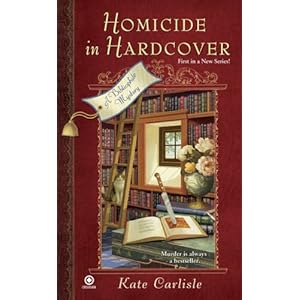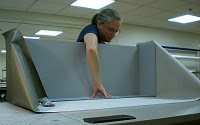Paper clips + brittle paper ≠ Good choice for book marks
Last Minute Gift Ideas
Welcome to the new version of our blog! We just migrated over to WordPress, please adjust your bookmarks accordingly. We have a new URL, but we have set up a re-direct for the old one so you can still find us.
The holiday season is upon us, and is our tradition we offer up some last minute gifts for that hard-to-buy-for conservator or preservation enthusiast on your list. This year it’s all about fiction and movies sine we read enough technical literature for our jobs. All work and no play…
 Books
Books
Homicide in Hardcover: A Bibliophile Mystery by Kate Carlisle. The description reads, “The streets of San Francisco would be lined with hardcovers if rare book expert Brooklyn Wainwright had her way. And her mentor wouldn’t be lying in a pool of his own blood on the eve of a celebration for his latest book restoration.” Intriguing, no?
The Sixteen Pleasures by Robert Hellenga. Written in 1995, the book follows a young conservator on her journey to Florence to help with the recovery of books affected by the floods of 1966 (a seminal year in the history of library conservation theory and practice). Along the way our heroine discovers more than just a rare volume of erotica.
The Kill Artist by Daniel Silva. Part of the Gabriel Allon series, the main character is an Israeli intelligence operative who also happens to be a paintings conservator. Don’t you think some of your colleagues may be secret undercover agents with mad spy skills?
Movies
 National Treasure. What better way to represent conservators than one that is willing to squirt lemon juice on the U.S. Constitution in the name of discovering long lost treasure? And Nicholas Cage is just fun to watch, in my opinion.
National Treasure. What better way to represent conservators than one that is willing to squirt lemon juice on the U.S. Constitution in the name of discovering long lost treasure? And Nicholas Cage is just fun to watch, in my opinion.
Ghostbusters II. Admittedly not as good as the original but still a fun movie filled with ectoplasm and all around hijinks. Siguorney Weaver’s character, Dana Barrett, is a paintings conservator.
Holly Hunter also plays a paintings conservator in Home for the Holidays. Why do paintings conservators get all the character lines? Anyway, a light and funny film especially good for those of you traveling to meet family this year.
More
For more finds be sure to visit Conservation Online’s listing of books, movies and more, all with a conservation theme or character. If you have any to add, leave us a note.
A Very Big Challenge
I think this is the biggest box I’ve tried to make, it’s for a Torah that was recently on exhibit and needs to go back to RBMSCL.
I’m experimenting with using double-walled corrugated board rather than binders board since it has strength but not weight. The board surface is easily marred but with the book cloth adhered it seems pretty solid. I’m going with a telescoping design, that is a smaller tray that has aslightly larger lid that fits over it.

What I’m not sure of yet is the design of the lid. The base is too big to make a lid from one piece of board, so I will have to cobble something together. I’m also considering experimenting with a polyester lid so you can see into the box. Nothing will be stored on top of this box, so having a sturdy lid may not be an issue, but would it provide enough protection? More thought is needed. Luckily the next few days are chock full of meetings, so I’ll have time to mull it over.
Happy Anniversary Preservation Underground!
 Today, Thanksgiving Day 2010, Preservation Underground turns one year old. It’s been quite a year, the department turned 10 years old and we celebrated with an exhibit and interviews with the staff (search “Tenth Anniversary Celebrations” and “Ten Years, Ten People” on our blog to find those). We’ve shared some fun projects like Boxing the Devil, scanning the Ehiopic scrolls, summer workshop adventures, and stuff we’ve found in books.
Today, Thanksgiving Day 2010, Preservation Underground turns one year old. It’s been quite a year, the department turned 10 years old and we celebrated with an exhibit and interviews with the staff (search “Tenth Anniversary Celebrations” and “Ten Years, Ten People” on our blog to find those). We’ve shared some fun projects like Boxing the Devil, scanning the Ehiopic scrolls, summer workshop adventures, and stuff we’ve found in books.
DIY Book Repair
 It’s an urge, an itch you can’t scratch. You see a broken book and you instinctively reach for the tape. You want to fix it, make it whole. We know how you feel, we feel the same way. But tape is not the way forward my friends…not for your valuable materials, the ones you want to pass down someday to your kids.
It’s an urge, an itch you can’t scratch. You see a broken book and you instinctively reach for the tape. You want to fix it, make it whole. We know how you feel, we feel the same way. But tape is not the way forward my friends…not for your valuable materials, the ones you want to pass down someday to your kids.
We see a lot of DIY book repairs. I think the people who try to fix our broken books at home are trying to do what they feel is right. The problem is that self adhesive tapes are too strong for brittle paper, it pulls pages out of bindings and often takes several pages at a time. Tape is very difficult or impossible to remove completely unless you use solvents, and it often can’t be removed without damaging the paper surface.
If you have something valuable and it is in need of repair don’t reach for the tape, reach out to a conservator. You can find one through the American Institute for Conservation. On their site they have information on finding and selecting a conservator as well as tips for preserving your treasures.
By the way, the image above shows an older DIY repair done with masking tape. I took a picture because the person carefully colored the tape so it would be less noticeable. I’m not sure it completely worked, but I give him/her credit for trying to make it a less obvious repair.
Going Old Skool
Remember Letraset It was a staple for me as a young art student back in the day. I found this in a book that came to the lab today. Smurfs and Letraset, totally old skool.
The book itself is a mess of problems. Besides Soccer Smurf here, the paper is very brittle, the binding is hanging on by a thread, and someone tried a DIY book repair (or three) with brown packing tape to keep pages together. Needless to say this is also on hold for a patron.
Proof of Life
 Have you ever been in the front of class or demonstrating something and thought to yourself “am I getting through to them?” A couple of weeks ago we held our annual week-long care and handling training to show staff and student assistants what sort of material to send to conservation.
Have you ever been in the front of class or demonstrating something and thought to yourself “am I getting through to them?” A couple of weeks ago we held our annual week-long care and handling training to show staff and student assistants what sort of material to send to conservation.
10 Years, 10 People: Beth Doyle
Your humble author rounds out the last of the Ten Years, Ten People series. I am the Head of Conservation Services and have been at Duke for eight years. I work with some amazing people and some equally amazing collections. The best part of my job right now is bringing you into the Underground to show you, dear reader, what it is that we do below decks. I hope you have found our sites informative and fun to visit.
In this video I share a personal story of unexpectedly finding an image of one of my ancestors in our collections in the Rare Book, Manuscript, and Special Collection Library.
httpv://www.youtube.com/watch?v=ZV5kwMbbjyw?fs=1
Paper Crumbs
 We just finished our fall semester Care and Handling sessions wherein we give out tips on safely handling library materials. We also display our “show of horrors” which covers amongst other things torn pages, food spills, damaged spines, and of course brittle paper.
We just finished our fall semester Care and Handling sessions wherein we give out tips on safely handling library materials. We also display our “show of horrors” which covers amongst other things torn pages, food spills, damaged spines, and of course brittle paper.
Care and Handling Training
Pop quiz: What is the best method of removing a book from the shelf?
This week we are presenting our annual week-long Care and Handling/Identifying Common Damage demonstrations. Each year we present our show of horrors to help new library staff and student assistants learn to identify damaged books. We also provide quick tips and helpful hints that can minimize potential damage when items are handled during our day-to-day work.
What we hope comes across is that everyone has a role to play in getting our materials to the shelf safely. We appreciate everyone’s help in keeping our collections around for a very long time.
If you work in the library, stop in to see a demonstration. Our sessions for the rest of the week are as follows (sessions are held in the conservation lab-Perkins 023-unless otherwise indicated):
10/19, 4pm, 6pm
10/20, 11:30am, 3pm (at Lily Library)
10/21, 10am (at Smith Warehouse), 1pm
10/22, 9:30am, 2pm
 The answer: push the books on either side of the one you want inwards, and grasp the covers. If you pull on the top of the book to remove it, the spine is likely to tear.
The answer: push the books on either side of the one you want inwards, and grasp the covers. If you pull on the top of the book to remove it, the spine is likely to tear.




